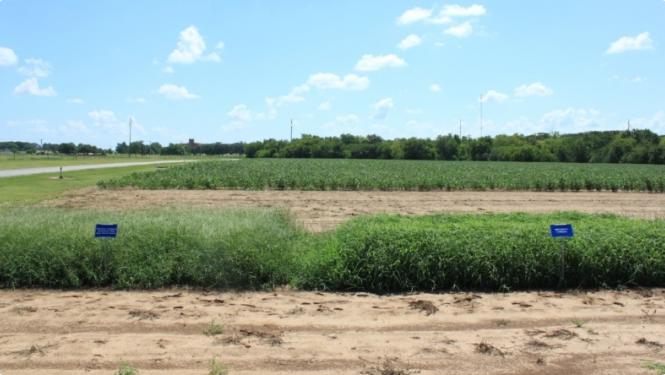Everyone knows crabgrass as a weed; few know it as a valuable summer annual forage. That view is changing with more and more producers planting and utilizing crabgrass as part of their forage-livestock production systems.
There are differences between the weedy type and the cultivated type. Both are botanically in the genus Digitaria. The weed is “hairy crabgrass” (Digitaria sanguinalis). The cultivated type is called “southern crabgrass”. Although southern crabgrassmay be a genetic variant of hairy crabgrass, most botanical taxonomists describe it as a separate species, Digitaria ciliaris.
The Samuel Roberts Noble Foundation’s (now Noble Research Institute) ‘Red River’ became the main commercial cultivar central to expanding the use of southern crabgrass as a cultivated summer annual over the past 25 years. An early flowering cultivar commercialized privately later was ‘Quick-n-Big’; it achieved limited use compared to Red River.
Although still successful, Red River’s relatively short vegetative period was a limitation. Noble’s forage breeders recently released a new later maturing cultivar called ‘Impact’. Impact’s late seedhead production and longer vegetative periods when compared to Red River is shown in the attached photo. Impact, Red River, Quick-n-Big, and a mechanical blend of Impact and Red River are now available for purchase in the commercial seed trade.

Why should producers use southern crabgrass?
Easy answer: its nutritive value is far superior to other warm-season grass options during summer for hay and grazing. It has high crude protein, high digestibility, and low neutral detergent fiber contents. Animal grazing gains easily reach 2 lbs/head/day; and consistently average 1.75 lbs/head/day over entire summer.
Additionally, southern crabgrass extends the grazing period when grown following winter annuals; sometimes providing up to 9 months of nearly continuous forage production. Southern crabgrass is also used as a renovation and conservation grass for quickly covering critical bare areas during summer. Its superior reseeding ability makes re-establishment easy and potentially reduces costs, although it is a good plan to add low rates of additional seed annually.
Establishment and Management
Soil test and apply phosphorus, potassium, and lime according to test recommendations. Nitrogen is normally applied at 75 to 100 pounds of actual nitrogen per acre spread evenly throughout the growing season. Crabgrass produces well over a wide range of soil pHs (5.0 to 7.5) but 6.2 to 6.5 is ideal.
Seeding rates range from 4 to 6 pounds of pure live seed per acre.
Three first-year planting methods are recommended:
- Over-seeding from mid-winter to April directly into existing winter annuals.
- Planting seed in a tilled, firm seedbed anytime from March through late May; repeat cultipacking after seeding. Recommended tillage include any plowing implement normally used (disk harrow, roto or turbo tiller, etc.)
- Planting to supplement thinning fescue or bermudagrass areas.
In subsequent years, fields to be utilized as crabgrass only (not double cropped with winter annuals):
- Should not be re-tilled if a uniform stand of crabgrass emerges by early spring; an additional 2-3 pounds per acre of seed can be over-sown.
- If poor natural reseeding stands, lightly till area anytime from mid-March to mid-April to promote existing carryover seed germination. Recommended tillage implements include disks, field cultivators, and sweep plows. Apply 2-3 pounds per acre of additional seed after tillage and before cultipacking, rolling, or dragging the area.
In subsequent years, stands to be double cropped with winter annuals:
- Tillage for seeding the winter annuals helps crabgrass the next summer.
- If a uniform stand of crabgrass emerges by the end of winter annual use, do not disturb the stand with tillage although an additional 2-3 pounds per acre of additional seed can be over-sown.
- If a good stand has not emerged by the end of the winter crop use, the area should be re-tilled, 2-3 pounds per acre of additional seed applied, and area cultipacked or dragged.
Planting to supplement thinning fescue or bermudagrass stands:
- To establish crabgrass, lightly till area with disks, field cultivators, or sweep plow before planting, seed at 4-6 lbs/acre, and cultipak, drag, or roll area.
- If the goal is to keep the existing base grass for future use, crabgrass should be grazed during summer (no hay production) as it will be grazed preferentially thus relieving pressure on the base grass.
- If the goal is to replace fescue or bermudagrass, then accumulation for hay is fine.
Crabgrass is best utilized in a well-managed rotational grazing system throughout the summer once initially attaining a good, dense stand.
Crabgrass is cut for hay when approximately 24 inches tall; leaving 4 to 6-inch stubble for regrowth that can be used later for grazing or hay.